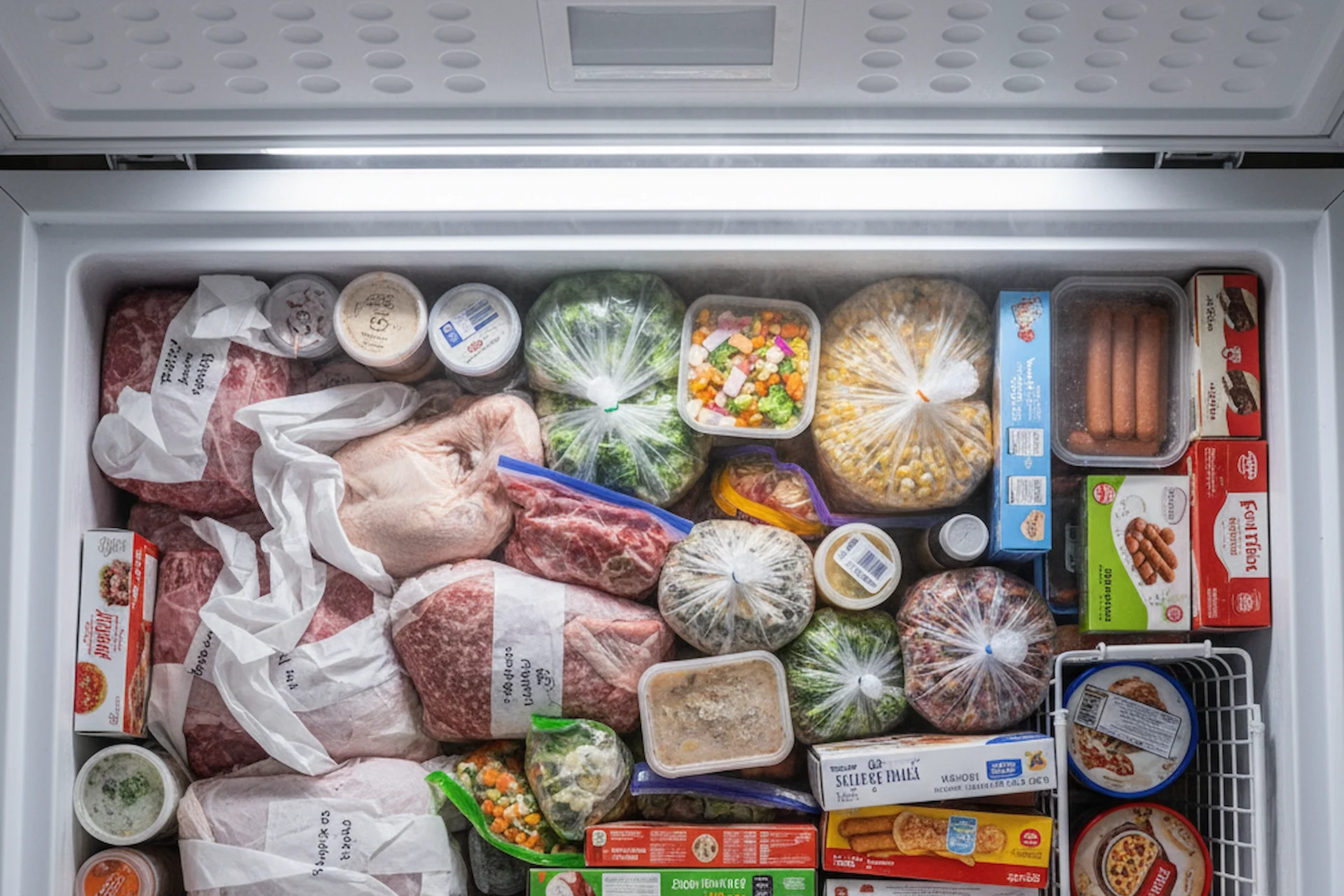
Question: Does Food Last Longer in a Chest Freezer?
Answer: Yes, food lasts longer in a chest freezer. Chest freezers maintain colder, more consistent temperatures. Since cold air sinks, less escapes when the lid is opened compared to an upright model. This stability significantly reduces freezer burn, preserving food quality for longer periods.
How Freezer Type Affects Food Longevity
Many people wonder if food lasts longer in a chest freezer. The answer is important for anyone who wants to reduce food waste and save money. Storing food properly preserves its flavour, texture, and nutritional value. The type of freezer you use plays a significant role in how long your food maintains its quality. Both chest freezers and upright freezers keep food frozen, but their designs lead to different storage environments. This difference directly impacts food preservation over long periods.
A chest freezer opens from the top, while an upright freezer opens from the front like a refrigerator. This simple design distinction is the primary reason for performance differences. Cold air is dense. It sinks. When you open a chest freezer’s lid, the cold air stays inside the compartment. Conversely, when you open an upright freezer’s door, the cold air spills out and is replaced by warmer room air. The freezer’s compressor must then work harder to cool the interior again. These temperature fluctuations can affect the quality of your stored food.
This article explores the key factors that determine why a chest freezer often provides a better environment for long-term food storage. We will examine temperature stability, the impact of defrost cycles, and how each design influences issues like freezer burn. Understanding these elements will help you make an informed decision about which freezer best suits your needs for preserving food effectively. We also offer practical tips to maximize the life of your frozen goods in any type of freezer.
The Science of Freezing and Food Preservation
Freezing is an excellent method of food preservation. It works by slowing down the movement of molecules. This process causes microbes, such as bacteria and mould, to enter a dormant state. Freezing stops these microorganisms from growing and spoiling the food. It also reduces the activity of enzymes, which are natural substances in food that can lead to spoilage and ripening. By effectively halting these biological processes, freezing keeps food safe to eat for an extended time.
However, freezing does not stop all physical changes. One common issue is freezer burn. Freezer burn occurs when food becomes dehydrated due to air exposure. It appears as grayish-brown, leathery spots on frozen food and negatively affects the texture and flavour. While the food remains safe to eat, its quality is significantly reduced. Proper packaging is the first line of defence against freezer burn. Using airtight containers or vacuum-sealing bags minimizes air contact and protects your food.
The stability of the freezer’s internal temperature is another critical factor. Constant temperature fluctuations, even minor ones, can degrade food quality. These shifts can cause small ice crystals on the food’s surface to melt and refreeze into larger, more damaging crystals. This process draws moisture out of the food, worsening freezer burn and altering its texture. A freezer that maintains a steady temperature provides a superior environment for long-term food preservation.
Click here for more information on cabinet refinishing Toronto
Related Article: How Do I Know If My Chest Freezer Is Going Bad?
Related Article: What Are the Disadvantages of a Chest Freezer?
Temperature Stability and Its Impact on Food Quality
Consistent temperature is the most important factor for preserving the quality of frozen food. The ideal temperature for long-term storage is a steady -18°C (0°F) or lower. At this temperature, the growth of microorganisms stops, and the chemical changes that affect food quality slow dramatically. Chest freezers excel at maintaining this steady, cold environment. Their design minimizes cold air loss, and they typically do not have auto-defrost cycles that introduce temperature variations.
The lack of an auto-defrost feature in most chest freezers is a key reason that food lasts longer. While manual defrosting is a chore, it means the freezer’s interior is not subjected to periodic warming cycles. This consistency prevents the repeated thawing and refreezing of ice crystals on the food’s surface. As a result, food stored in a chest freezer retains its original texture, colour, and flavour for a longer duration. This makes them the preferred choice for storing valuable items like bulk meat purchases or garden harvests.
The Role of Auto-Defrost Cycles
Many upright freezers include an auto-defrost or frost-free feature for convenience. This system works by using a heating coil to periodically warm the freezer’s interior, melting any frost buildup. While this saves you the effort of manual defrosting, it creates regular temperature fluctuations. The temperature can rise several degrees during each cycle. These small but frequent changes are enough to degrade food quality over time, causing changes in texture and promoting the development of freezer burn.
Practical Tips for Maximizing Food Longevity in Any Freezer
Regardless of whether you own a chest or an upright freezer, you can take steps to ensure your food stays fresh for as long as possible. Proper storage techniques are crucial for preserving quality and preventing waste. Implementing these strategies will help you get the most out of your freezer investment and keep your food tasting great. Following these simple guidelines protects your food from freezer burn and helps maintain its nutritional value.
Your first step should always be to use the right packaging. Air is the enemy of frozen food. Use high-quality freezer bags, plastic wrap, or airtight containers to create a barrier. For the best results, a vacuum sealer removes nearly all the air, providing maximum protection against dehydration and oxidation. Always cool foods completely before freezing them. Placing hot items in the freezer raises the internal temperature, which can partially thaw nearby foods and force the freezer to work overtime.
-
Label and Date Everything
Use a permanent marker to label every package with its contents and the date it was frozen. This practice helps you identify items easily and follow the “first-in, first-out” rule, ensuring you use older items before they lose quality. -
Organize for Airflow
A full freezer is more efficient than an empty one, but do not overstuff it. Leave some space between packages to allow cold air to circulate freely. Proper circulation ensures all items freeze quickly and stay at a consistent temperature. Use bins or baskets in a chest freezer to group similar items for easier access. -
Limit Lid and Door Openings
Every time you open your freezer, you let warm air in. This causes temperature fluctuations that can harm your food. Try to minimize the time the door or lid is open. Decide what you need before you open it to retrieve items quickly.
How Manual Defrosting Benefits Food Preservation
The need to manually defrost a chest freezer is often seen as its biggest disadvantage. This process involves emptying the freezer, letting the ice melt, and cleaning the interior. While it requires time and effort, this lack of an automated system is precisely why food lasts longer in a chest freezer. Without an auto-defrost cycle, the freezer’s internal temperature remains incredibly stable. There are no periodic warming phases that can compromise the quality of your food.
Auto-defrost systems in upright freezers create convenience at the expense of food quality. These systems use a small heater that turns on several times a day to melt frost from the evaporator coils. This process raises the temperature inside the freezer just enough to affect the food stored within. The surface of the food can slightly thaw and then refreeze, which leads to the formation of large ice crystals. This cycle slowly degrades the food’s texture, making meats tough and vegetables mushy over time.
By maintaining a consistently deep freeze, a manual-defrost chest freezer provides a superior environment for long-term storage. The food experiences minimal temperature variation from the moment it is frozen until it is removed. This stability is critical for preserving the cellular structure of foods, which in turn preserves their flavour and texture. If your primary goal is to store food for many months or even years, the benefits of a manual-defrost system far outweigh the inconvenience of occasional cleaning.
Conclusion
After examining the evidence, it is clear that food does last longer and maintains better quality in a chest freezer. The core reasons are superior temperature stability, efficient cold air retention, and the absence of damaging auto-defrost cycles. The horizontal design of a chest freezer naturally keeps cold air contained, even when the lid is open. This efficiency means the compressor works less, temperatures stay consistent, and your food remains in a deeply frozen state. This environment is ideal for long-term preservation, effectively protecting against freezer burn and textural degradation.
The choice between a chest and an upright freezer ultimately depends on your priorities. If your main goal is to buy food in bulk and store it for extended periods, a chest freezer is the superior option. It provides the most stable environment to preserve the quality of your meat, produce, and prepared meals for months or even years. The trade-off is the inconvenience of manual defrosting and the difficulty of organizing and accessing items at the bottom. The effort is rewarded with better-tasting, higher-quality food when you finally use it.
If convenience and organization are more important to you, an upright freezer is a perfectly suitable choice for everyday use. Its shelves and door bins make finding items simple, and the auto-defrost feature eliminates a significant chore. While it may not preserve food for as long as a chest freezer, you can mitigate quality loss by using proper packaging and minimizing how long you keep the door open. For most households that cycle through their frozen goods relatively quickly, an upright freezer offers a practical balance of performance and usability.

Blue Malue Get in touch with Blue here.
